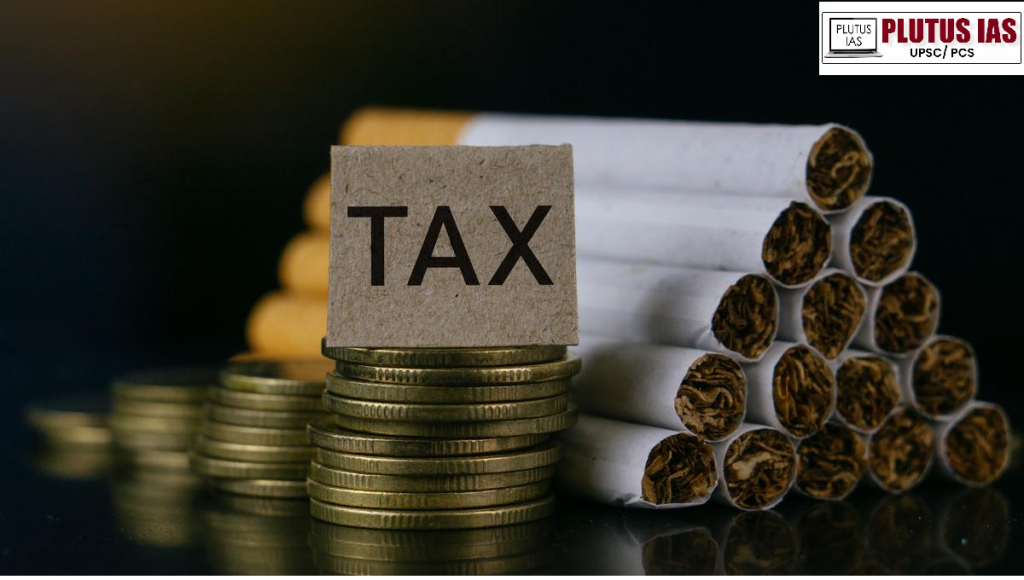08 Jul Health vs Revenue: The Missed Potential of GST in Tobacco Control
This article covers “Daily Current Affairs” and the Topic Health vs Revenue: The Missed Potential of GST in Tobacco Control
SYLLABUS MAPPING:
GS-3- Economics- Health vs Revenue: The Missed Potential of GST in Tobacco Control
FOR PRELIMS
What role does the GST Council play in determining tobacco tax policy?
FOR MAINS
What are the main benefits of GST in India since its introduction in 2017?
Why in the News?
As India marks the 8th anniversary of GST on July 1, 2025, debates have resurfaced over its unfinished agenda, particularly in tobacco taxation. While GST has boosted revenue and formalised the economy, no significant tax hikes on tobacco have occurred since its rollout. Public health experts stress the need to raise GST and excise duties on tobacco to curb consumption and meet WHO norms. The GST Council’s ongoing rate rationalisation discussions provide a timely opportunity to correct these gaps.

Economic Impact of GST
Revenue Performance:
In FY 2024–25, GST collections reached an impressive ₹22.08 lakh crore, reflecting a 9.4% increase from the previous year. This growth highlights improved tax compliance and continued economic resilience.
Efficiency Gains:
Cost Efficiency: The Input Tax Credit (ITC) system has significantly reduced tax cascading and lowered production costs.
Digitization: The introduction of digital tools such as e-invoicing and e-way bills has increased transparency, traceability, and compliance.
Logistics Improvements: The removal of inter-state checkpoints has reduced transportation time by 20%, cutting fuel consumption and improving supply chain logistics.
Tobacco Taxation under GST: Concerns and Gaps
Health and Economic Impact
Tobacco use claims over 3,500 lives daily in India and imposes an annual economic burden of approximately ₹2.34 lakh crore due to healthcare costs and productivity losses. Despite this, India has not fully harnessed its tax policy under GST to curb tobacco consumption.
Stalled Tax Progress Since GST
Before GST, periodic tax hikes contributed to a notable 17% reduction in tobacco use. However, since GST’s implementation, there has been no significant increase in the effective tax burden on tobacco products.
Inadequate Tax Incidence
Current effective tax rates fall short of the WHO-recommended 75% of retail price:
Bidis: ~22%
Cigarettes: ~54%
Smokeless Tobacco: ~65%
The reliance on ad valorem taxation (percentage-based) reduces effectiveness, particularly for cheaper products like bidis, which remain widely accessible and affordable.
Structural Inequities and Policy Recommendations
Unequal Tax Burden
Despite making up just 15% of tobacco users, cigarettes account for over 80% of tobacco tax revenues. Conversely, bidis—mostly consumed by the rural poor and tribal communities—are under-taxed, perpetuating both health risks and fiscal inequity.
Recommended Reforms
Elevate GST Rates: Place all tobacco products in the highest tax slab of 40%, especially bidis.
Strengthen Specific Excise Duties: Reintroduce and scale up specific taxes on bidis and smokeless products.
Adopt a Mixed Tax Model: A hybrid structure combining ad valorem and specific components would ensure price sensitivity and predictable revenues while enhancing public health impact.
Illicit Trade: Myths vs Reality
Industry Narratives vs Data
While tobacco companies often claim that high taxes drive illicit trade (citing figures up to 25%), independent research shows the actual share of illicit tobacco is between 2.7% and 6.6%.
Role of Governance
Illicit trade thrives not due to tax rates, but weak enforcement, porous borders, and poor regulatory mechanisms. India has ratified the WHO Protocol to Eliminate Illicit Trade in Tobacco Products, yet its implementation remains limited. Strengthening governance, not lowering taxes, is the appropriate response.
Legal, Institutional, and Treaty Obligations
1. The GST Council (under Article 279A of the Constitution) is empowered to set tax rates.
2. Tobacco also attracts a Compensation Cess, but specific excise duties—especially on bidis—have largely disappeared post-GST.
3. India is a signatory to the WHO Framework Convention on Tobacco Control (FCTC), which calls for fiscal measures to reduce consumption. Current taxation levels fall short of this commitment.
Learning from Global Best Practices
Countries like Thailand and the Philippines have successfully used ‘sin taxes’ to fund healthcare systems. Australia, through annual tax hikes and plain packaging laws, now boasts one of the world’s lowest smoking rates. India, too, can follow this model—regularly increasing specific duties and directing revenues toward public health schemes like Ayushman Bharat.
Environmental and Ethical Dimensions
Tobacco farming contributes to deforestation, soil degradation, and heavy pesticide use. The bidi industry is often associated with exploitative labour practices, including child labour and unsafe working conditions. Morally, reliance on revenues from a harmful product contradicts developmental ethics. A just transition for bidi workers toward safer livelihoods is urgently needed.
Q. Consider the following statements regarding tobacco taxation in India under GST:
1. All tobacco products are currently taxed at the highest GST slab of 40%.
2. Bidis contribute the majority of tobacco tax revenue in India.
3. India is a party to the WHO Framework Convention on Tobacco Control.
4. Specific excise duties on tobacco products have been fully retained after GST implementation.
Which of the statements given above is/are correct?
A. 1 and 2 only
B. 3 only
C. 1, 3 and 4 only
D. 2 and 4 only
Answer: B
Mains Questions
Q. Discuss the limitations of tobacco taxation under the Goods and Services Tax (GST) regime in India. Suggest policy measures to align tobacco taxation with public health goals, equity, and international commitments.
(250 words, 15 marks)




No Comments